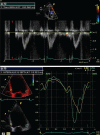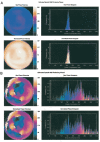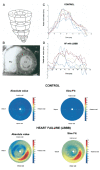Patient assessment for cardiac resynchronization therapy: Past, present and future of imaging techniques
- PMID: 20101354
- PMCID: PMC2827221
- DOI: 10.1016/s0828-282x(10)70332-9
Patient assessment for cardiac resynchronization therapy: Past, present and future of imaging techniques
Abstract
It has been proposed that dyssynchrony assessment before cardiac resynchronization therapy (CRT) implantation could help predict response to CRT. It is known that up to 40% of patients who receive a CRT device for established indications do not respond to CRT. Great expectations came from the Predictors of Response to Cardiac Resynchronization Therapy (PROSPECT) study, which would finally identify the ultimate echocardiographic dyssynchrony criteria to help select responders. The recently published PROSPECT trial failed to identify an ideal parameter of dyssynchrony. Patient selection for CRT should involve a multimodal approach, and new promising tools are being investigated in that view. The present review integrated new data coming from the exciting field of imaging with currently available evidence to generate a stepwise approach to patient selection.
Il est postulé que l’évaluation de la désynchronisation avant une thérapie de resynchronisation cardiaque (TRC) peut contribuer à prévoir la réponse à l’intervention. On sait que jusqu’à 40 % des patients qui reçoivent un dispositif de TRC en raison d’indications établies n’y réagissent pas. On avait de grandes attentes à l’égard de l’étude PROSPECT sur les prédicteurs des réponses à la TRC, qui devait enfin déterminer les critères ultimes de désynchronisation échocardiographique afin de sélectionner les personnes y réagissant. Cette étude, qui a récemment été publiée, n’a pu déterminer de paramètre idéal de désynchronisation. La sélection des patients admissibles à une TRC devrait faire l’objet d’une démarche multimodale, et de nouveaux outils prometteurs sont en cours d’exploration à cet effet. La présente analyse intègre de nouvelles données tirées du domaine passionnant de l’imagerie et propose des données probantes à jour pour produire une démarche progressive de sélection des patients.
Figures









Similar articles
-
Left ventricular resynchronization is mandatory for response to cardiac resynchronization therapy: analysis in patients with echocardiographic evidence of left ventricular dyssynchrony at baseline.Circulation. 2007 Sep 25;116(13):1440-8. doi: 10.1161/CIRCULATIONAHA.106.677005. Epub 2007 Sep 4. Circulation. 2007. PMID: 17785624
-
Stress echocardiography for selecting potential responders to cardiac resynchronisation therapy.Heart. 2010 Jul;96(14):1142-6. doi: 10.1136/hrt.2010.199828. Heart. 2010. PMID: 20610460 Review.
-
Predictors of response to cardiac resynchronization therapy--importance of left ventricular dyssynchrony.Rev Port Cardiol. 2006 Jun;25(6):569-81. Rev Port Cardiol. 2006. PMID: 17019976 English, Portuguese.
-
Usefulness of echocardiographic dyssynchrony in patients with borderline QRS duration to assist with selection for cardiac resynchronization therapy.JACC Cardiovasc Imaging. 2010 Feb;3(2):132-40. doi: 10.1016/j.jcmg.2009.09.020. JACC Cardiovasc Imaging. 2010. PMID: 20159638
-
Assessment of mechanical dyssynchrony in cardiac resynchronization therapy.Dan Med J. 2014 Dec;61(12):B4981. Dan Med J. 2014. PMID: 25441737 Review.
Cited by
-
Time intervals and myocardial performance index by tissue Doppler imaging.Intern Emerg Med. 2011 Oct;6(5):393-402. doi: 10.1007/s11739-010-0469-3. Epub 2010 Oct 14. Intern Emerg Med. 2011. PMID: 20949333 Review.
-
Early occurrence of heart failure hospitalization or ventricular arrhythmia re-define the long-term prognosis after CRT.ESC Heart Fail. 2025 Aug;12(4):2780-2790. doi: 10.1002/ehf2.15274. Epub 2025 Mar 19. ESC Heart Fail. 2025. PMID: 40107322 Free PMC article.
-
Left Atrium Reverse Remodeling in Fusion CRT Pacing: Implications in Cardiac Resynchronization Response and Atrial Fibrillation Incidence.J Clin Med. 2024 Aug 15;13(16):4814. doi: 10.3390/jcm13164814. J Clin Med. 2024. PMID: 39200955 Free PMC article.
-
Tissue Doppler imaging in coronary artery diseases and heart failure.Curr Cardiol Rev. 2012 Feb;8(1):43-53. doi: 10.2174/157340312801215755. Curr Cardiol Rev. 2012. PMID: 22845815 Free PMC article. Review.
-
An early proof-of-concept of cardiac resynchronization therapy.World J Cardiol. 2011 Dec 26;3(12):374-6. doi: 10.4330/wjc.v3.i12.374. World J Cardiol. 2011. PMID: 22216372 Free PMC article.
References
-
- Chung ES, Leon AR, Tavazzi L, et al. Results of the Predictors of Response to CRT (PROSPECT) Trial. Circulation. 2008;117:2608–16. - PubMed
-
- Bleeker GB, Bax JJ, Wing-Hong Fung J. Clinical versus echocardiographic parameters to asses response to cardiac resynchronization therapy. Am J Cardiol. 2006;97:260–3. - PubMed
-
- Beshai JF, Grimm RA, Hagueh SF, et al. Cardiac resynchronisation therapy in heart failure with narrow QRS complexes. N Engl J Med. 2007;357:2461. - PubMed
-
- Cleland J, Daubert JC, Erdmann E, et al. The effect of cardiac resynchronization on morbidity and mortality in heart failure. N Engl J Med. 2005;352:1539–49. - PubMed
-
- Bristow MR, Saxon LA, Boehmer J, et al. Comparison of Medical Therapy, Pacing and Defibrillation in Heart Failure (COMPANION) Investigators Cardiac resynchronization therapy with or without an implantable defibrillator in advanced chronic heart failure. N Engl J Med. 2004;350:2140–50. - PubMed
Publication types
MeSH terms
LinkOut - more resources
Full Text Sources
Other Literature Sources
Medical
Research Materials
Miscellaneous

